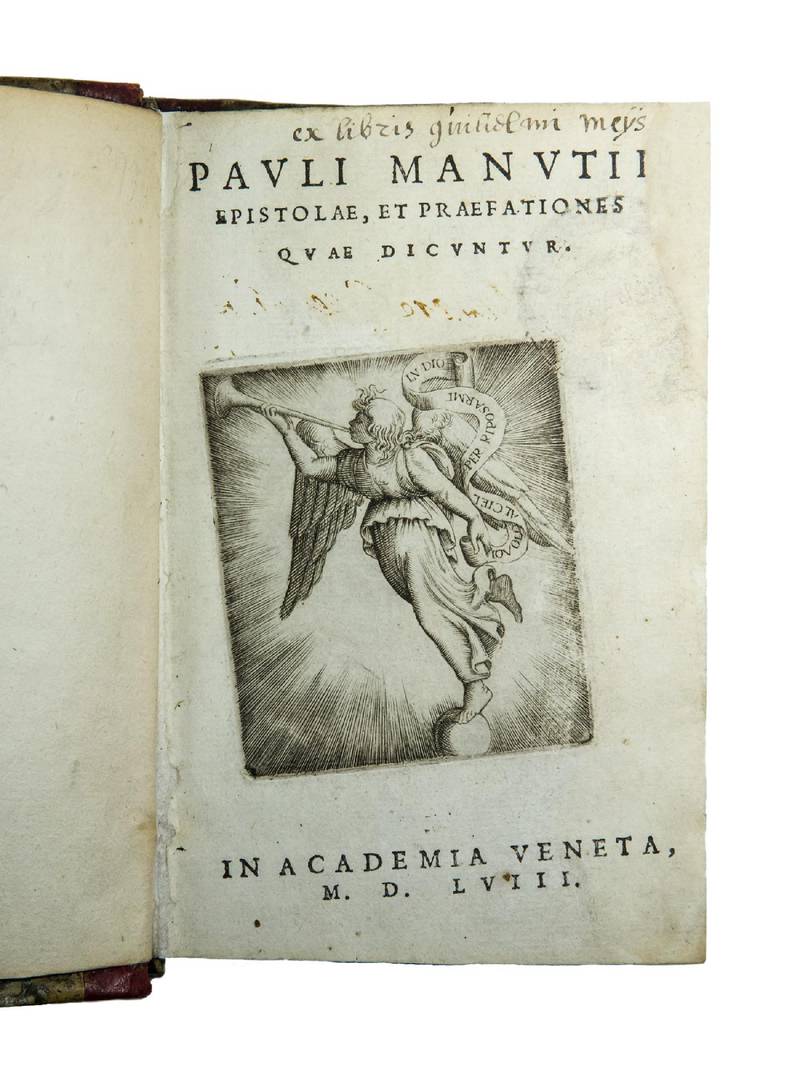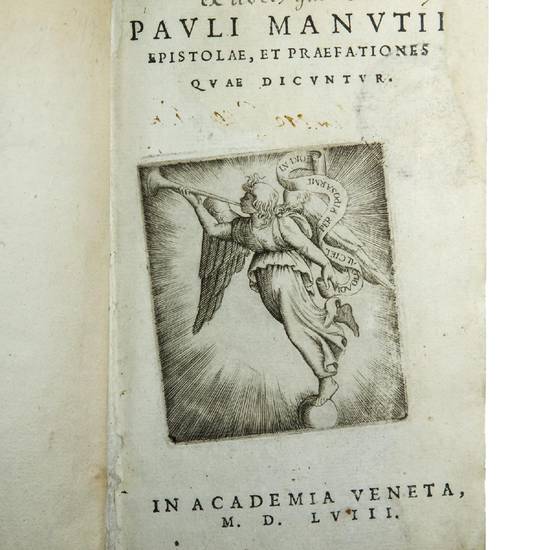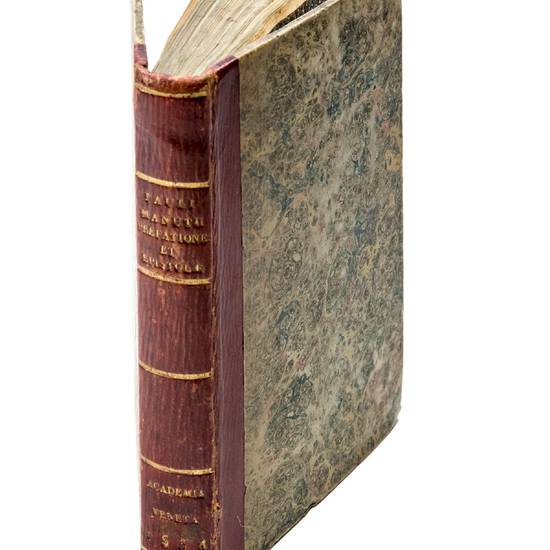8vo. (12), 5-148 leaves. A8, a8, B-S8, T4. With the engraved emblem of the Accademia della Fama on the title-page. Old manuscript annotations on the margins. Later ownership entry by Guilelmus Meys. Early ninteenth century red half-calf, gilt spine, marbled edges.
Adams, M-483; Edit 16, CNCE 23095; A. Renouard, Annali delle edizioni aldine, (Paris, 1834), p. 271, no. 9; E. Pastorello, L'epistolario Manuziano. Inventario cronologico-analitico, 1483-1597, (Firenze, 1957), p. 14, no. 244.
FIRST EDITION, dedicated to Alberico Cibo Malaspina, of the first collection of Paolo Manuzio's Latin letters (overall 84), to which are also added the most important dedication letters (praefationes, overall 21) to his hitherto published works.
“On comprend alors l'importance des lettres-préfaces que Manuce place en tête de ses principales éditions, en particulier celles de Cicéron, où l'on aurait tort de voir un répertoire de lieux communs. En s'adressant aux membres éminents de la Curie et de la noblesse italienne qu'il sait favorable aux disciplines libérales, l'érudit s'efforce de parfaire dans ce grands âmes l'idéal politique et spirituel qu'elles diffuseront dans leur propre circle pour qu'il devienne le ciment de la Cité et de son organisation hiérarchique. Tel est le programme qu'expose emblématiquement l'épître dédicatoire des Lettres et Préfaces (1558), jointe à tous les rééditions, où Manuce célèbre Laurent de Médicis, modèle du princeps cicéronien alliant iustitia, temperantia et liberalitas, et se conciliant par la gloire de ses mérites la faveur de ses concitoyens et des nations étrangères” (C. Mouchel, Paul Manuce épistolier: grandeur et misère de l'écrivain cicéronien, in: “Bibliothèque d'Humanisme et Renaissance”, LIV/3, 1992, p. 647).
An augmented edition in four books appeared in 1560, followed by one in five books in 1561, one in eight books in 1569, one in ten books in 1571, and a final one in eleven books in 1573. Posthumously were published collections in twelve books in 1580 and in fourteenth books by Andreas Schott in 1624.
“C'est la première édition des élégantes lettres et préfaces de Paul Manuce, si souvent réimprimées depuis; elle ne contient que celles des lettres qui, dans les éditions suivantes, forment les trois premiers livres, et un petit nombre de préface. Ces lettres n'ont pas été réimprimées sans altération. Dès la deuxième édition faite en 1560, le nom de Flaminius disparoît d'une lettre adressée à Stephano Saulio, fol. 4. Dans des éditions ultérieures, d'autres noms ont été supprimés ou remplacés” (Renouard, op. cit., p. 271).
“Nel 1558 [Paolo Manuzio] fu coinvolto da Federico Badoer nel prestigioso progetto dell'Accademia della Fama, con l'incarico di stampare tutte le opere che l'istituzione avrebbe pubblicato. L'ambizioso programma del patrizio veneziano dovette ancora una volta dargli l'illusione di poter avere un ruolo importante in un'accademia che, nei desideri del fondatore, avrebbe dovuto avere un rapporto privilegiato con le istituzioni veneziane. Il segno di tale nuova progettualità lo conferma il fatto che nel 1558 Paolo pubblicò un'antologia delle sue lettere in latino, in un'elegante edizione all'insegna dell'Accademia della Fama, che conteneva in appendice una raccolta di praefationes: si trattava di ventuno dedicatorie che avevano accompagnato alcune delle sue più importanti edizioni e che, ancora una volta, testimoniavano le sue relazioni, non solo ai vertici della gerarchia ecclesiastica, ma anche tra i rappresentanti della diplomazia francese, con i quali era entrato in contatto tra gli anni trenta e quaranta” (L. Braida, Libri di lettere. Le raccolte epistolari del Cinquecento tra inquietudini religiose e ‘buon volgare', Bari, 2009, pp. 172-173).
“Das gedruckte Corpus der Briefe des Paulus Manutius [...] scheint als wichtiges Bindeglied zwischen italienischer und transalpiner Epistolographie zur Zeit des Späthumanismus eine Schlüsselstellung eingenommen zu haben. Offenbar fand es als epistolographisches Schulbuch weite Verbreitung” (B.R. Jenny, Die Amerbachkorrespondenz. Von der humanistischen Epistolographie zur bürgerlichen Briefstellerei, in: “Der Brief im Zeitalter der Renaissance”, F.J. Worstbrock, ed., Weinheim, 1983, pp. 204-205).
“Mais la fin du genre épistolaire n'est nullement de poursuivre une recherche spécifique, parallèle à celle des traités érudits. Chaque lettre est une méditation, c'est-à-dire un exercice et un effort de l'auteur pour témoigner de sa puissance à donner formulation excellente aux principes excellents de l'humanistas, ramenée à la réalisation toujours plus parfaite des quatre personae que définit le De officis. Manuce n'a jamais eu d'autre objectif que de faire coïncider à la cime de l'âme la part la plus généreuse de la philosophie de Cicéron – son platonisme et son stoïcisme – avec la noblesse et la suavité de son style, reconquises de l'intérieur” (C. Mouchel, op. cit., p. 641).
The Accademia della Fama or Accademia Veneta was founded in 1558 by the Venetian noblemen Federico Badoer, Domenico Venier, and Girolamo Molino, and was dissolved only three years later due to conflicts with the Venetian authorities. This extravagant organization was a large, ambitious, and fatally costly undertaking designed formally along the lines of the Aldine Neacademia to serve the public needs of scholarship in science, arts, and letters. Its separate departments, the Consiglio Iconomico, Consiglio Politico, Consiglio delle Scientie, and Oratorio, were intended collectively to embrace the whole of the Renaissance encyclopaedia and thereby ensure the moral and scientific education of the state. As announced in a series of three published constitutions, various suppliche, and letters, it aimed to cover the full range of disciplines, since all pertained “to the public and private interests”. The academy was defunct after less than four years. Charged with the publication of the academician's literary activities was the printer Paolo Manuzio (cf. P. Pagan, Sulla Accademia Venetiana o della Fama, in: “Atti dell'Istituto Veneto di Scienze, Lettere ed Arti”, 132, 1973-74, pp. 359-92).
(Epistolae:)
Farnese, Ranuccio. Venezia, [December 19 p., 1544] (l. 5r)
Carafa, Alfonso [Venezia, March 15 p., 1557] (l. 6r)
Sauli, Stefano [Venezia, July 27 p., 1553] (l. 7v)
id. [Venezia, Fall, 1553] (l. 10v)
id. Venezia, [December 2 p., 1558] (l. 13r)
Fabro, Guido. Venezia, [November 28, 1546] (l. 16v)
Cervini, Marcello. Venezia, [Fall, 1539] (l. 18r)
Maffei, Bernardino. Venezia, [May 1, 1542] (l. 20r)
Caziano, Gabriele. Venezia, [October 16, 1540] (l. 21r)
Luisini, Francesco. Venezia, [December 29, 1546] (l. 22v)
Contarini, Paolo. Pieve di Sacco, [September 1, 1552] (l. 24r)
Madruzzo, Cristoforo. Venezia, [Spring, 1557] (l. 27r)
Cervini, Romolo. Roma, [May, 1537] (l. 28r)
Gonzaga, Francesco. Venezia, [April 24 p., 1557] (l. 28v)
Possevino, Antonio. Venezia, [April 24 p., 1557] (l. 29v)
Lippomano, Girolamo. Asola, [Summer, 1556] (l. 30v)
id. Venezia, [1558] (l. 32v)
Vargas, Francisco de. Venezia, [Summer, 1556] (l. 33v)
Faleti, Girolamo. [Venezia, June?, 1557] (l. 35r)
Ex libro de quatuor rebuspub[licis] (l. 36r)
Nizolio, Mario. Asola, [Summer, 1556] (l. 40r)
Antoniano, Silvio. Venezia, [Winter, 1558] (l. 41v)
Ricci, Bartolomeo. Venezia, [December 12, 1556] (l. 43r)
Agustin, Antonio. [Venezia, 1554] (l. 44v)
id. Venezia, [1552?] (l. 44v)
id. Venezia, [1556/7] (l.45r)
id. Venezia, [1557/8] (l. 46r)
id. Venezia, [January?, 1558] (l. 47v)
Ramberti, Benedetto. Venezia, [September, 1544] (l. 48r)
Corrado, Mario. Venezia, [April 24, 1557] (l. 48v)
Stella, Fabio. Asola, [August/September, 1557] (l. 49v)
Pastori, Giovanni Battista. Asolo, [August/September, 1557] (l. 50v)
Stella, Vincenzo. Asola, [October, 1557] (l. 51r)
Hotman, François, Venezia, [first half of 1557] (l. 51v)
id. Venezia, [Winter, 1558] (l. 52r)
[Sturm, Johannes]. Venezia, [June, 1556] (l. 52v)
id. Venezia, [1556/7] (l. 54r)
Furnarino, Girolamo. Venezia, [April, 1557] (l. 55r)
Torrentius [Van der Becke], Levinus. Venezia, [Spring, 1557?] (l. 55v)
Leoni, Sebastiano. [Venezia, Fall?, 1558] (l. 56r)
Lombardini, Marco Antonio. [Venezia, Fall?, 1555] (l. 57v)
Proemium libri de magistratibus Romanis (l. 58r)
Ferranti, Cesare. Venezia, [Fall, 1558] (l. 60v)
Lolli, Guido. Pisa, [May 31, 1543] (l. 61v)
Caro, Annibal. Venezia, [July, 1540] (l. 62v)
Maggi, Ottaviano. Venezia, [Spring, 1558], (l. 63v)
Este, Ippolito d‘. Venezia, [January 25?, 1558] (l. 64r)
Molin, Francesco. Venezia, [April 29 p., 1558], (l. 65v)
Muret, Marc-Antoine. [Venezia, August 25 p., 1558] (l. 66r)
id. [Venezia, March 4 p., 1558] (l. 66v)
id. Venezia, [August 25 a., 1558] (l. 67r)
id. Venezia, September 5, [1558] (l. 68r)
id. [Venezia, March 28 a., 1558] (l. 69r)
id. Venezia, [early August, 1558] (l. 70r)
id. [Venezia, April 12 p., 1558] (l. 71r)
id. Venezia, [June 5, 1558] (l. 71v)
id. [Venezia, July 19, 1558] (l. 72r)
id. Venezia, [April, 17, 1558] (l. 73r)
id. [Venezia, September 4?, 1558], (l. 73v)
id. [Venezia, April 18, 1558] (l. 74v)
id. Venezia, [May 18 a., 1558] (l. 75r)
id. Venezia, [May 19 p., 1558] (l. 75v)
id. Venezia, [April 23, 1558] (l. 76v)
id. [Venezia, April 24, 1558] (l. 77r)
id. [Venezia, April 29, 1558] (l. 77v)
id. Venezia, [May 9, 1558] (l. 78v)
id. Venezia, [May 6, 1558] (l. 79r)
id. [Venezia, May 7, 1558] (l. 79v)
id. [Venezia, May 19, 1558] (l. 80r)
id. [Venezia, May 14, 1558] (l. 80r)
id. Venezia, [May 27, 1558] (l. 80v)
id. Venezia, [September 2, 1558] (l. 81v)
id. Venezia, [September 2 p., 1558] (l. 82r)
Ramusio, Giovanni Battista. Pieve di Sacco, October 14, [1552](l. 83v)
Natta, [Marco] Antonio. [Venezia, May 12 a., 1557], (l. 86r)
id. Venezia, [April, 1557] (l. 86v)
id. [Venezia, January 25, 1558] (l. 87v)
id. Venezia, [February 9 p., 1558] (l. 88r)
id. [Venezia, June 1 p., 1557] (l. 88v)
id. Asola, [August 28 a., 1557] (l. 89r)
id. [Venezia, December 16, 1557] (l. 90r)
id. [Venezia, April 5 p., 1558] (l. 91r)
id. Venezia, [February 23 p., 1558] (l. 91r)
id. [Venezia, August 7 a., 1558] (l. 91v)
id. Venezia, [July 1 p., 1558] (l. 92r)
id. Venezia, [June 1, 1558] (l. 92r)
(Praefationes:)
Sanarega, Matteo. Venezia, May 1554 (l. 93r)
Pesaro, Carlo. Venezia, 1558 (l. 95v)
Accolti, Bendetto. [Venezia, October, 1540] (l. 98r)
Du Bellay, Guillaume. [ Venezia, February, 1541] (l. 100r)
Cesarini, Alessandro. [Venezia, March, 1541] (l. 101v)
Monluc, Jean de. Venezia, 1546 (l. 103r)
Ramberti, Benedetto. [Venice, May, 1540] (l. 106v)
Hurtado de Mondoza, Diego. [Venezia, August, 1540] (l. 108r)
Cervini, Macello. [Venezia, August p., 1540] (l. 111r)
Farnese, Ranuccio. Venezia, 1548 (l. 113r)
Carafa, Alfonso. [Venezia, April, 1557] (l. 116r)
Elio, Antonio. [Venezia, April, 1556] (l. 122v)
Morvillier, Jean de. Venezia, 1551 (l. 126r)
Este, Ippolito d‘. Venezia, 1557 (l. 127v)
Faleti, Girolamo. [Venezia, Winter, 1557] (l. 130v)
Villamarina, Isabella. [Venezia, 1546] (l. 133v)
Bembo, Torquato. [Venezia, 1546] (l. 135r)
Ramusio, Paolo. Venezia, 1557 (l. 138r)
Trivulzio, Antonio. Venezia, [March 15 p.], 1555 (l. 142r)
Garzoni, Luigi. Venezia, 1558 (l. 145v)
Ghisleri, Michele. Venezia, [September 11 a.], 1558 (l. 147v)
Paolo was the youngest son of Aldo Manuzio the Elder. He had the misfortune to lose his father at the age of two. After this event his grandfather and two uncles, the three Asolani, carried on the Aldine Press, while Paolo prosecuted his early studies at Venice. Excessive application hurt his health, which remained weak during the rest of his life. At the age of twenty-one he had acquired a solid reputation for scholarship and learning.
In 1533 Paolo undertook the conduct of his father's business, which has latterly been much neglected by his uncles. Paolo determined to restore the glories of the house, and in 1540 he separated from his uncles. The field of Greek literature having been well night exhausted, he devoted himself principally to the Latin classics. He was a passionate Ciceronian, and perhaps his chief contributions to scholarship are the corrected editions of Cicero's letters and orations, his own epistles in a Ciceronian style, and his Latin version of Demosthenes. Throughout his life he combined the occupations of a scholar and a printer, winning an even higher celebrity in the former field than his father had done. Four treatises from his pen on Roman antiquities deserve to be commemorated for their erudition no less than for the elegance of their Latinity.
Several Italian cities contended for the possession of so rare a man. He also received tempting offers from the Spanish court. Although his publications were highly esteemed, their sale was slow. Thus his life was a permanent struggle with pecuniary difficulties. In 1556 he received for a time external support from the Accademia Veneta, founded by Federico Badoer, who failed disgracefully in 1559, and the academy was extinct in 1562. Meanwhile Paolo had established his brother Antonio, a man of good parts but indifferent conduct, in a printing office and book shop at Bologna. Antonio died in 1559, having been a source of trouble and expense to Paolo during the last four years of his life. Other pecuniary embarrassment arose from a contract for supplying fish to Venice, into which Paolo had somewhat strangely entered with the government.
In 1561 Pius IV invited him to Rome, offering him a yearly stipend of 500 ducats, and undertaking to establish and maintain his press there. The profits were to be divided between Paolo Manuzio and the Apostolic Camera. Paolo accepted the invitation, and spent the larger portion of his life, under three papacies, with various fortunes in the city of Rome. The works published by the Stamperia del Popolo Romano were mostly Latin works of theology and Biblical or patristic literature. Meanwhile his eldest son, the younger Aldo, had succeeded him in the management of the Venetian printing house. Overtaxed with studies and commercial worries Paolo died at Rome in his sixty-second year (cf. T. Sterza, Paolo Manuzio editore a Venezia (1533-1561), in: “ACME. Annali della Facoltà di lettere e filosofia dell'Università degli studi di Milano”, 61/2, 2008, pp. 123-168; and F. Barberi, Paolo Manuzio e la stamperia del popolo romano (1561-1570): con documenti inediti, Roma, 1942, passim).
[9160]





